Pistachio
| Pistacia vera | |
|---|---|
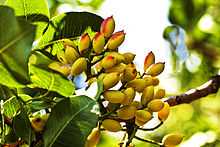 | |
| Pistacia vera (Kerman cultivar) fruits ripening | |
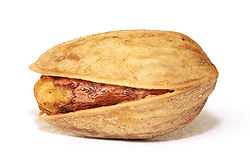 | |
| Roasted pistachio seed with shell | |
| Conservation status | |
| Scientific classification | |
| Kingdom: | Plantae |
| (unranked): | Angiosperms |
| (unranked): | Eudicots |
| (unranked): | Rosids |
| Order: | Sapindales |
| Family: | Anacardiaceae |
| Genus: | Pistacia |
| Species: | P. vera |
| Binomial name | |
| Pistacia vera L. | |
The pistachio, (/pɪˈstæʃiˌoʊ/, -/stɑːʃiˌoʊ/, Persian: پسته; Pistacia vera) a member of the cashew family, is a small tree originating from Central Asia and the Middle East.[1][2] Pistachio trees can be found in regions of Iran, Syria, Lebanon, Turkey, Greece, Xinjiang (China), Tunisia, Kyrgyzstan, Tajikistan, Turkmenistan, India, Egypt, Italy (Sicily), Uzbekistan, Afghanistan (especially in the provinces of Samangan and Badghis), and the United States, specifically in California. It is indigenous to the eastern Mediterranean (Cyprus and Turkey to Israel and Syria), Central Asia (Turkmenistan, Uzbekistan, Afghanistan, Tajikistan, and Kyrgyzstan) and Xinjiang.[3] The tree produces seeds that are widely consumed as food.
Pistacia vera often is confused with other species in the genus Pistacia that are also known as pistachio. These species can be distinguished from P. vera by their geographic distributions (in the wild), and their seeds which are much smaller and have a shell that is soft.
History
Pliny the Elder writes in his Natural History that pistachio seeds were a common food as early as 6750 BC.[1] asserts that pistacia, “well known among us,” was one of the trees unique to Syria, and that the seed was introduced into Italy by the Roman Proconsul in Syria, Lucius Vitellius the Elder (in office in 35 AD) and into Hispania at the same time by Flaccus Pompeius.[4] The early sixth-century manuscript De observatione ciborum (“On the observance of foods”) by Anthimus implies that pistacia remained well known in Europe in Late Antiquity. The pistachio is one of three seeds mentioned in the Bible. The pistachio is mentioned once, in Genesis 43:11, as is the walnut in Song of Songs 6:11, while the almond is mentioned many times. Archaeologists have found evidence from excavations at Jarmo in northeastern Iraq.[1] The Hanging Gardens of Babylon were said to have contained pistachio trees during the reign of King Merodach-Baladan about 700 BC.[1] The modern pistachio P. vera was first cultivated in Western Asia, where it has long been an important crop in cooler parts of Iran and Iraq. It appears in Dioscurides as pistakia πιστάκια, recognizable as P. vera by its comparison to pine nuts.[5] Its cultivation spread into the Mediterranean world by way of Persia from Syria.
Additionally, remains of the Atlantic pistachio and pistachio seed along with nut-cracking tools were discovered by archaeologists at the Gesher Benot Ya'aqov site in Israel's Hula Valley, dated to 78,000 years ago.[6] More recently, the pistachio has been cultivated commercially in many parts of the English-speaking world, in Australia, and in New Mexico[7] and California, of the United States, where it was introduced in 1854 as a garden tree.[8] David Fairchild of the United States Department of Agriculture introduced hardier cultivars collected in China to California in 1904 and 1905, but it was not promoted as a commercial crop until 1929.[7][9] Walter T. Swingle’s pistachios from Syria had already fruited well at Niles by 1917.[10]
The earliest records of pistachio in English are around roughly year 1400, with the spellings “pistace” and “pistacia”. The word pistachio comes from medieval Italian pistacchio, which is from classical Latin pistacium, which is from ancient Greek pistákion and pistákē, which is generally believed to be from Middle Persian, although unattested in Middle Persian. Later in Persian, the word is attested in Persian as pesteh. As mentioned, the tree came to the ancient Greeks from Western Asia.[11]
Botany
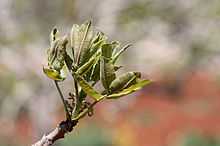
Habitat
Pistachio is a desert plant, and is highly tolerant of saline soil. It has been reported to grow well when irrigated with water having 3,000–4,000 ppm of soluble salts.[7] Pistachio trees are fairly hardy in the right conditions, and can survive temperatures ranging between −10 °C (14 °F) in winter and 48 °C (118 °F) in summer. They need a sunny position and well-drained soil. Pistachio trees do poorly in conditions of high humidity, and are susceptible to root rot in winter if they get too much water and the soil is not sufficiently free-draining. Long, hot summers are required for proper ripening of the fruit. They have been known to thrive in warm moist environments.
The Jylgyndy Forest Reserve, a preserve protecting the native habitat of Pistacia vera groves, is located in the Nooken District of Jalal-Abad Province of Kyrgyzstan.
Characteristics
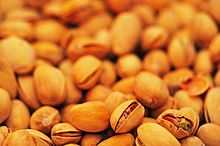
The bush grows up to 10 m (33 ft) tall. It has deciduous pinnate leaves 10–20 centimeters (4–8 inches) long. The plants are dioecious, with separate male and female trees. The flowers are apetalous and unisexual, and borne in panicles.
The fruit is a drupe, containing an elongated seed, which is the edible portion. The seed, commonly thought of as a nut, is a culinary nut, not a botanical nut. The fruit has a hard, creamish exterior shell. The seed has a mauvish skin and light green flesh, with a distinctive flavor. When the fruit ripens, the shell changes from green to an autumnal yellow/red, and abruptly splits part way open (see photo). This is known as dehiscence, and happens with an audible pop. The splitting open is a trait that has been selected by humans.[12] Commercial cultivars vary in how consistently they split open.
Each pistachio tree averages around 50 kilograms (110 lb) of seeds, or around 50,000, every two years.[13]
The shell of the pistachio is naturally a beige color, but it is sometimes dyed red or green in commercial pistachios. Originally, dye was applied by importers to hide stains on the shells caused when the seeds were picked by hand. Most pistachios are now picked by machine and the shells remain unstained, making dyeing unnecessary except to meet ingrained consumer expectations. Roasted pistachio seeds can be artificially turned red if they are marinated prior to roasting in a salt and strawberry marinade, or salt and citrus salts.
Like other members of the Anacardiaceae family (which includes poison ivy, sumac, mango, and cashew), pistachios contain urushiol, an irritant that can cause allergic reactions.[14]
Cultivation
| Top Ten Pistachio Producers in 2012[15] | |||
|---|---|---|---|
| Rank | Country | Production (metric tonnes) | Yields (ton/hectare) |
| 1 | | 472,097 | 1.78 |
| 2 | | 231,000 | 4.27 |
| 3 | | 150,000 | 3.03 |
| 4 | | 74,000 | 1.53 |
| 5 | | 57,195 | 2.48 |
| 6 | | 10,000 | 2.6 |
| 7 | | 2,850 | 1.76 |
| 8 | | 2,000 | 1.43 |
| 9 | | 1,792 | 0.06 |
| 10 | | 1,400 | 1.33 |
| — | World | 1,005,210 | 2.03 |
Iran, the United States and Turkey are the major producers of pistachios.[2] The trees are planted in orchards, and take approximately seven to ten years to reach significant production. Production is alternate-bearing or biennial-bearing, meaning the harvest is heavier in alternate years. Peak production is reached around 20 years. Trees are usually pruned to size to make the harvest easier. One male tree produces enough pollen for eight to 12 drupe-bearing females. Harvesting in the United States and in Greece is often accomplished using equipment to shake the drupes off the tree. After hulling and drying, pistachios are sorted according to open-mouth and closed-mouth shells. Sun-drying has been found to be the best method of drying,[16] then they are roasted or processed by special machines to produce pistachio kernels.
Pistachio trees are vulnerable to a wide variety of diseases. Among these is infection by the fungus Botryosphaeria, which causes panicle and shoot blight (i.e., kills flowers and young shoots), and can damage entire pistachio orchards.
In California, almost all female pistachio trees are the cultivar 'Kerman'. A scion from a mature female 'Kerman' is grafted onto a one-year-old rootstock. Male pistachios may be a different variety.
In 2013, the City Council of Avenal, California, proclaimed the city to be the Pistachio Capital of the World, reflecting the importance of the pistachio industry to the city's economy.[17]
In Greece, the cultivated type of pistachios is different. It has an almost-white shell, a sweet taste, a red-green kernel and a little bit more closed-mouth shell than the 'Kerman' variety. Most of the production in Greece comes from the island of Aegina and the region of Thessaly-Almyros.
Bulk container shipments of pistachio kernels are prone to self-heating and spontaneous combustion because of their high fat and low water contents.[18]
Consumption
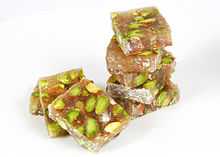
The kernels are often eaten whole, either fresh or roasted and salted, and are also used in pistachio ice cream, kulfi, spumoni, historically in Neapolitan ice cream, pistachio butter,[19][20] pistachio paste[21] and confections such as baklava, pistachio chocolate,[22] pistachio halva,[23] pistachio lokum or biscotti and cold cuts such as mortadella. Americans make pistachio salad, which includes fresh pistachios or pistachio pudding, whipped cream, and canned fruit.[24]
In July 2003, the Food and Drug Administration (FDA) approved the first qualified health claim specific to seeds lowering the risk of heart disease: "Scientific evidence suggests but does not prove that eating 1.5 ounces (42.5 g) per day of most nuts, such as pistachios, as part of a diet low in saturated fat and cholesterol may reduce the risk of heart disease".[25]
China is the top pistachio consumer worldwide, with annual consumption of 80,000 tons, while the United States consumes 45,000 tons. Russia (with consumption of 15,000 tons) and India (with consumption of 10,000 tons) are in the third and fourth places.[26]
Nutritional Information
| Nutritional value per 100 g (3.5 oz) | |
|---|---|
| Energy | 2,391 kJ (571 kcal) |
|
27.65 g | |
| Sugars | 7.81 g |
| Dietary fiber | 10.3 g |
|
45.97 g | |
|
21.35 g | |
| Vitamins | |
| Vitamin A equiv. |
1205 μg |
| Thiamine (B1) |
(73%) 0.84 mg |
| Riboflavin (B2) |
(13%) 0.158 mg |
| Niacin (B3) |
(10%) 1.425 mg |
|
(10%) 0.513 mg | |
| Vitamin B6 |
(98%) 1.274 mg |
| Folate (B9) |
(13%) 50 μg |
| Vitamin C |
(3%) 2.3 mg |
| Trace metals | |
| Calcium |
(11%) 110 mg |
| Iron |
(32%) 4.2 mg |
| Magnesium |
(34%) 120 mg |
| Manganese |
(61%) 1.275 mg |
| Phosphorus |
(69%) 485 mg |
| Potassium |
(22%) 1042 mg |
| Zinc |
(24%) 2.3 mg |
| |
|
Percentages are roughly approximated using US recommendations for adults. Source: USDA Nutrient Database | |
The fat profile of pistachios is roughly 14% saturated fat, 54% monounsaturated fat and 32% polyunsaturated fat. A 1-cup serving of pistachio seeds contains 6.143 g (94.80 gr) of saturated palmitic fatty acid, only 0.585 g (9.03 gr) of stearic fatty acid and trace amounts of arachidic and behenic saturated fatty acids.
Toxin and safety concerns
As with other tree seeds, aflatoxin is found in poorly harvested or processed pistachios. Aflatoxins are potent carcinogenic chemicals produced by molds such as Aspergillus flavus and Aspergillus parasiticus. The mold contamination may occur from soil, poor storage, and spread by pests. High levels of mold growth typically appear as gray to black filament-like growth. It is unsafe to eat mold-infected and aflatoxin-contaminated pistachios.[27] Aflatoxin contamination is a frequent risk, particularly in warmer and humid environments. Food contaminated with aflatoxins has been found as the cause of frequent outbreaks of acute illnesses in parts of the world. In some cases, such as Kenya, this has led to several deaths.[28]
Pistachio shells typically split naturally prior to harvest, with a hull covering the intact seeds. The hull protects the kernel from invasion by molds and insects, but this hull protection can be damaged in the orchard by poor orchard management practices, by birds, or after harvest, which makes it much easier for pistachios to be exposed to contamination. Some pistachios undergo so-called “early split”, wherein both the hull and the shell split. Damage or early splits can lead to aflatoxin contamination.[29] In some cases, a harvest may be treated to keep contamination below strict food safety thresholds; in other cases, an entire batch of pistachios must be destroyed because of aflatoxin contamination. In September 1997, the European Union placed its first ban on pistachio imports from Iran due to high levels of aflatoxin. The ban was lifted in December 1997 after Iran introduced and improved food safety inspections and product quality.[27]
Pistachio shells may be helpful in cleaning up pollution created by mercury emissions.[30]
See also
References
- ↑ 1.0 1.1 1.2 1.3 "History and Agriculture of the Pistachio Nut". IRECO. Retrieved 27 February 2012.
- ↑ 2.0 2.1 "Pistachios". IGA. Retrieved 27 February 2012.
Iran, Iraq and Tunisia are the major producers of pistachios.
- ↑ AL-Saghir, M.G., and D.M. Porter. 2012. Taxonomic revision of the genus Pistacia L. (Anacardiaceae). American Journal of Plant Sciences, 3: 12-32.
- ↑ Pliny's Natural History, xiii.10.5, xv.22.
- ↑ James Strong, ed. Cyclopaedia of Biblical, Theological, and Ecclesiastical Literature, s.v. "Nut".
- ↑ "Remains of seven types of edible nuts and nutcrackers found at 78,000-year-old archaeological site". Scienceblog.com. February 2002. Retrieved 2010-09-13.
- ↑ 7.0 7.1 7.2 Esteban Herrera (1997) Growing pistachios in New Mexico, New Mexico State University, Cooperative Extension Service, Circular 532
- ↑ Introduction to Fruit Crops (Published Online), Mark Rieger, Rieger asserts that pistachios began to be commercially harvested in the 1970s. 2006
- ↑ Fairchild, David (1938). The World Was My Garden. New York: Charles Scribner's Sons. p. 174. ISBN 0-686-84310-X.; Commissioner of Horticulture of the State of California,Biennial report1905/06, vol. II:392.
- ↑ Liberty Hyde Bailey, Cyclopedia of American Agriculture: II.Crops, 1917, s.v."Importance of plant introduction" p.
- ↑ ref2, ref2.
- ↑ Towards a comprehensive documentation and use of Pistacia genetic diversity in Central and West Asia, North Africe and Europe, Report of the IPGRI Workshop, 14–17 December 1998, Irbid, Jordan – S.Padulosi and A. Hadj-Hassan, editors
- ↑ Nugent, Jeff; Julia Boniface (30 March 2005). "Pistachio Nuts". Permaculture Plants: A Selection. Permanent Publications. p. 41. ISBN 978-1-85623-029-2. Retrieved 17 June 2008.
- ↑ Mabberley, D. J. (1993). The Plant Book. Cambridge: Cambridge Univ. Press. p. 27. ISBN 0-521-34060-8.
- ↑ "Top Production - Pistachios, 2010". FAO. 2011.
- ↑ Abbas, K. A.; Saleh, A. M.; Lasekan, Ola; Khalil, Sahar K. (2010). "A Review on Factors Affecting Drying Process of Pistachio and Their Impact on Product’s Quality". Journal of Agricultural Science 2 (1): 3–15.
- ↑ Avenal City Council Resolution No. 2013-68 adopted on November 14, 2013
- ↑ "13.6 Risk factor Self-heating/Spontaneous combustion". Container Handbook. GDV. Retrieved 17 June 2008.
- ↑ Ardekani, A. S. H.; Shahedi, M.; Kabir, G. (2009). "Optimizing Formulation of Pistachio Butter Production" (PDF). Journal of Science and Technology of Agriculture and Natural Resources 13 (47): 49–59.
- ↑ Ardakani; Shahedi, M.; Kabir, G. (2006). Optimizing of the process of pistachio butter production. Acta Horticulturae 726. pp. 565–568.
- ↑ Shakerardekani, A.; Karim, R.; Mohd Ghazali, H.; Chin, N. L. (2011). "Effect of roasting conditions on hardness, moisture content and colour of pistachio kernels" (PDF). International Food Research Journal 18: 704–710.
- ↑ Ardakani (2006). The vital role of pistachio processing industries in development of Iran non-oil exports. Acta Horticulturae 726. pp. 579–581.
- ↑ Shaker Ardakai, A.; Mir Damadiha, F.; Salehi, F.; Shahedi, M.; Kabir, G. H.; Javan Shah, A. et al. (2007). "Pistachio Halva Production". Document Number: 29328 (Iran Pistachio Research Institute).
- ↑ "Pistachio Salad". RecipeSource. Retrieved 17 January 2011.
- ↑ Office of Nutritional Products, Labeling and Dietary Supplements (23 July 2003). "Qualified Health Claims: Letter of Enforcement Discretion – Nuts and Coronary Heart Disease (Docket No 02P-0505)". Center for Food Safety and Applied Nutrition. Archived from the original on 17 June 2008. Retrieved 17 June 2008.
- ↑ "No. 3686 | Domestic Economy | Page 4". Irandaily. Retrieved 17 January 2011.
- ↑ 27.0 27.1 E. Boutrif (1998). "Prevention of aflatoxin in pistachios" (PDF). FAO, United Nations.
- ↑ "Aflatoxins in pistachios" (PDF). European Union. 2008.
- ↑ Doster and Michailides (1994). "Aspergillus Moulds and Aflatoxins in Pistachio Nuts in California". Phytopathology 84 (6): 583–590. doi:10.1094/phyto-84-583.
- ↑ "Unlikely Mix: Used Tires, Pistachio Shells Can Clean Up Pollution". Sciencedaily.com. 2000. Retrieved 6 February 2012.
External links
| Wikimedia Commons has media related to Pistachio. |
| Look up pistachio in Wiktionary, the free dictionary. |
![]() Chisholm, Hugh, ed. (1911). "Pistachio Nut". Encyclopædia Britannica (11th ed.). Cambridge University Press.
Chisholm, Hugh, ed. (1911). "Pistachio Nut". Encyclopædia Britannica (11th ed.). Cambridge University Press.
| ||||||||||||||||||
